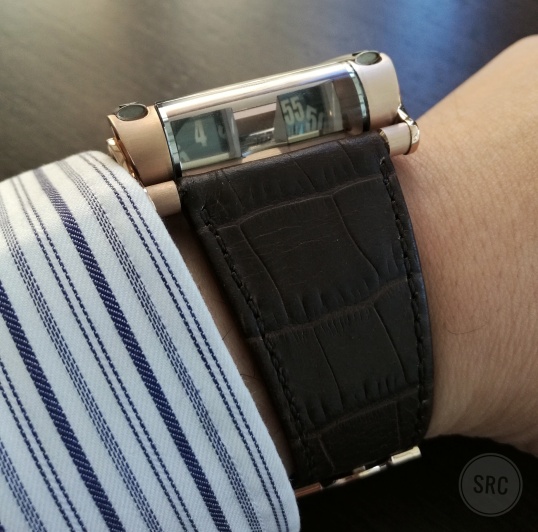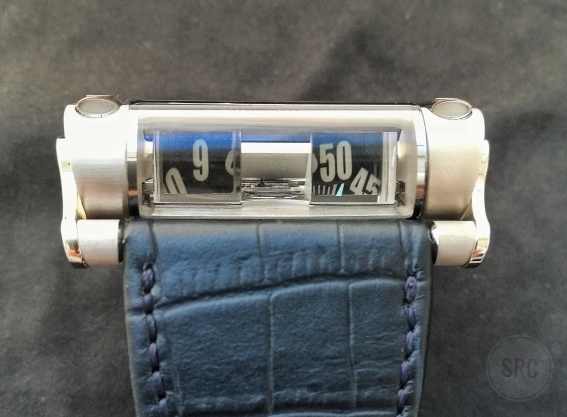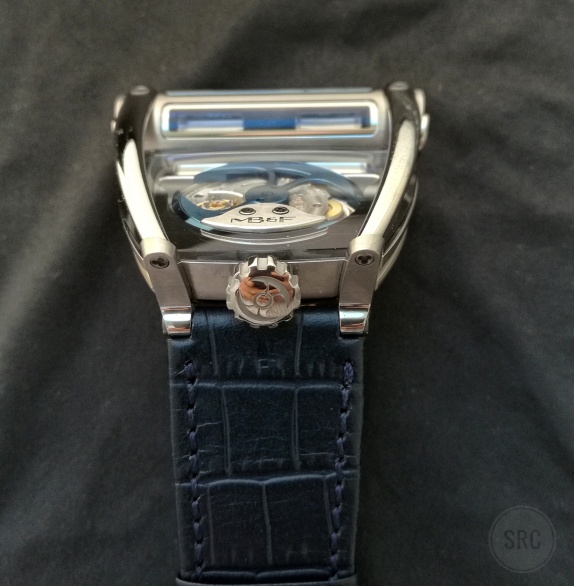By SRC
MB&F have always been a brand that I have kept a keen eye on because of their unconventional approach to watchmaking, so I was excited about the opportunity to again meet MB&F’s Head of Communication Charris Yadigaroglou, and get my hands on Max’s (and his talented group of friends’) latest brainchild.
The HM8 did not disappoint.
After the HM5 and HMX, the HM8 is the third car-themed “Horological Machine” from the brand, this time inspired by the Can-Am (Canadian-American Challenge Cup) race cars. At 40mm x 51.5mm, my first impression was that it is a watch with significant wrist presence, but not overly so. The part-titanium construction of the case and the articulating front lugs make it very comfortable to wear despite the size. I found it easy to both read the time and admire the different parts of the watch whilst on my wrist.
The HM8 is similar to the HM5 and HMX in that the jumping hours and minutes are displayed via two optical prisms (or one in the case of HM5), and the case take on a curved wedge shape, tapering towards the back. What’s different this time around is the movement have been flipped over, with MB&F’s signature battle axe winding rotor atop the movement and once again the centre of attention, reminiscent of the HM3.
Therefore, it comes as no surprise that MB&F playfully suggest that HM8 = HM3 + HM5. An amusing background story is that while MB&F completed the HM7 and HM8 at roughly the same time, they have decided to produce and release the HM8 first as this year (2016) coincides with the 50th Anniversary of the Can-Am Championship.
It was then a choice between renaming the HM8 to HM7 (in order to keep the numerical order of the Horological Machines), or break with tradition and call it HM8 and thereby skip HM7. In a coincidental stroke of genius, they recognised the connection between the watch, and HM3 and HM5, thus sealing its fate as Horological Machine No. 8.
The Girard Perregaux-based movement, excluding the prism module, is actually quite thin, and this is made evident with the slimness of the case. It is worth noting that the optical prisms are mounted directly onto the movement for the HM8, as opposed to being case-mounted in previous models. The new approach has the benefit that once mounted to the movement, the prisms won’t need further adjustments when the movement itself is installed into the case.
Visually, the HM8 is a feast for the eyes. The level of finishing for the watch is executed to a high level, consistent with the other Horological Machines, and the attention to detail is spectacular. The combination of curves and angles in the case design strike a delicate balance to create a beautiful form, and the design team used a mix of polished, brushed, and frosted finishes in different areas to great effect. Two curved, polished-titanium bars that extend from above the prism display to the back of the case took their inspiration from the roll-bars of the Can-Am race cars, and contributes to the three-dimensionality of the otherwise thin case.
Adorning the top of the case is a layer of sapphire glass revealing the movement and rotor underneath it. Part of the sapphire glass is coated with a material that give it a mirror-like appearance, forming a frame around the rotor. Double AR coating is also obvious as under certain angles, one wonders whether there is anything between one’s finger and the rotor. With the smooth-spinning battle axe rotor displayed prominently, this is a watch that will attract others attention to your wrist, even from a distance.
The hour and minute discs are visible not only though the optical prisms, but also in the two corners of the sapphire crystal directly above the discs, as well as through a sapphire glass window behind the time display, all to maximise the amount of light hitting the Super-LumiNova coated digits on the two discs.
Throughout the watch are an abundance of other familiar design elements shared with past creations: MB&F’s signature screws, signature lug screws, crown with engraved battle-axe logo, and ‘oil sumps’ similar to the HMX (these are now at the bottom side of the watch). MB&F never take their design process lightly, with some forty 3D models created to perfect the form for the HM8 and no details spared.
Another feature of MB&F watches which takes my fancy is their spring-loaded folding buckle. It doesn’t snap together with a click unlike standard butterfly folding buckles. Rather, the buckle is closed by a strong spring mechanism which snap closes the buckle when you fold it, and the buckle is held closed simply by the tension of the spring. As a result, there is a small tolerance to cushion wrist movements that improve comfort.
While it is hard for me to say whether this is my favourite MB&F watch, I can safely declare the HM8 to be my favourite race-car inspired watch by Max so far. Combining an unusual time display with a distinctive yet sophisticated case have always been MB&F’s formula for success and the HM8 is yet another outstanding example of what they do best.
The MB&F HM8 comes in two versions at the time of writing, in 18k white gold and titanium (HM8 CAN-AM WT) and in 18k 5N+ red gold and titanium (HM8 CAN-AM RT).
I would like to take this opportunity to thank Charris from MB&F and Ching from The Hour Glass Australia for being generous with their time and allowing me the pleasure of seeing and handling the HM8.
Categories: Hands-on, MB&F, Sydney, Watch Profile, watches









OMG SRC. So Jelly you got to see and wear and play with the HM8. Is it comfortable to wear ? I can’t wait to see it, soon, I hope.
LikeLike
@Initialjh It was certainly a lucky day. It’s actually quite ok to wear, partly because of its lightness as well. You definitely should go and see it! 🙂
LikeLike